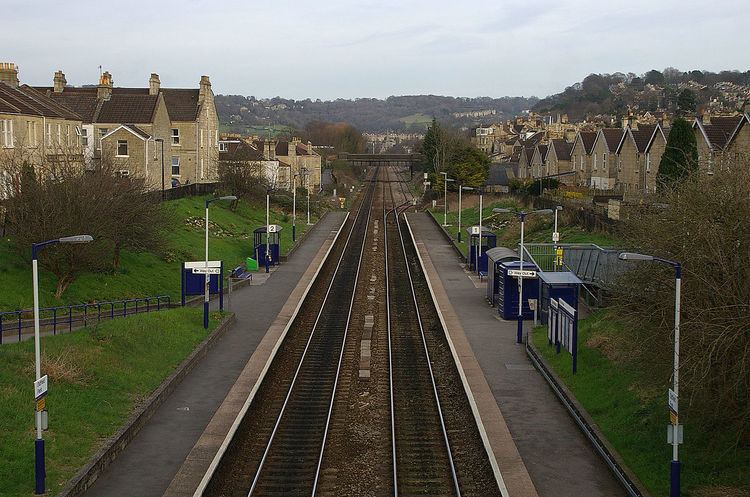Place Bath Station code OLF Number of platforms 2 | Grid reference ST736645 | |
 | ||
Local authority | ||
Oldfield Park railway station is on the Great Western Main Line in South West England, serving the mainly residential areas of southern Bath, Somerset. It is 107 miles 72 chains (173.6 km) down-line from London Paddington and is situated between Bath Spa and Keynsham stations.
Contents
It is managed by Great Western Railway, which also operates most of the trains that call. South West Trains operate a limited number of services. The station is located at the junction of Brook Road and Moorland Road; the Brook Road bridge links the two platforms.
It opened in 1929, though the line through the site had opened in 1840.
History
Oldfield Park was the third station to be constructed in Bath on the G.W.R. line. It is the only station whose platforms are below the surrounding road levels, all the rest of Bath's G.W.R. stations are elevated. The Railway line divides Bath's road systems into two distinct areas.
Many new road bridges were necessary to overcome the difficulty posed to local goods traffic by this new railway. The Station is located between two such road bridges, one to the east is called Brougham Hayes bridge. It was originally built on the Tudor arch style of local stone. It was later demolished and replaced with a widened steel and stone structure. This occurred in the early 20th century when an extra line to a goods yard was laid to the end of the westbound platform. Brook Road bridge adjoins the station a short distance to the west.
The majority of Brunel's design for Bath was raised up on a system of earth embankments and stone arches. His objective in all his designs were to maintain his "billiard table" design philosophy. The main obstacle was a skew bridge crossing of the River Avon to link with the main Bath Spa station in the centre of the City. At the approach to the Oldfield Park section a cutting was necessary to maintain the desired level. It was into these cutting embankments that the two platforms were later accommodated.
To some extent Oldfield Park replaced an earlier station at Twerton, three-quarters of a mile to the west, which had closed, ostensibly temporarily, in the First World War and which had been badly affected by competing bus and tram services. The Twerton station never reopened.
The platforms were designed solely to enable passenger access to the carriages. The limited road and platform access made the handling of bulky goods very difficult. To the east of the westbound platform a single section of line was added from the Westmoreland goods yard in Lower Oldfield Park. This area of ground on the same level as Brunel's railway line was used as a stone yard and marshalling yard for goods wagons. It formed the only G.W.R. terminal in Bath with the necessary access to be able to handle heavy goods.
There was originally a full-time station master and ticket office. The 1929 ticket office was constructed of timber on tall wooden piles attached to both the Brook Road bridge and the ground below. It was located at the Moorland Road side of the bridge at road level. This has now been replaced by a portacabin styled ticket office on the westbound platform and a ticket dispensing machine. The ticket office is manned on weekdays during the morning peak times. The station is also part of the Penalty Fares area.
Legislation was passed that ensured disabled users had easy access to public areas, the current long access ramp evolved to replace the earlier wooden steps. This new much extended ramp now leads passengers down to the replacement ticket office. Access to the Eastbound platform is via a sloping path leading from the top of Brook Road, and further eastwards a set of steps lead down from Stuart Place.
Community support
Since 2006 there have been a number of local schemes to improve the appearance and the environment surrounding the Station. These have included some landscaping and the planting of shrubs and flowers. In 2010 there were a team of 12 full-time volunteers, and local school children are involved with the project. The number of passengers using the station is now on the increase. This is due in part to the pressure from both the local people and their elected representatives in local government upon First Great Western to improve services.
Services
Passenger services are operated by Great Western Railway. There is generally an hourly service to Gloucester via Bristol Temple Meads, extending to Great Malvern via Worcester Shrub Hill on certain journeys. There are also trains to Cardiff Central in the morning peak. In the other direction, trains run to a wide range of destinations.
These include Westbury, Salisbury, Southampton Central and Portsmouth Harbour as well as Castle Cary and stations to Weymouth; there is one service a day to Brighton and a single direct morning commuter service to Chippenham and Swindon. Commuters for London Paddington must change at Bath Spa. On Sundays the service is less frequent.
